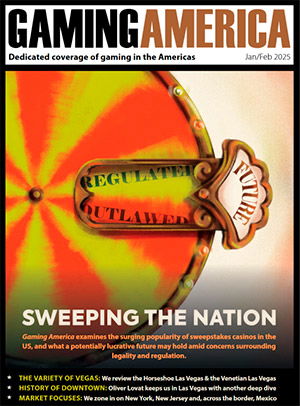US commercial gaming hits record Q2 revenue of $17.6B, extending growth streak to 14 quarters

The commercial US gaming industry increased by 8.9% reaching $17.63 billion in Q2, according to the American Gaming Association’s Commercial Gaming Revenue Tracker. Q2 was the 14th consecutive quarter of year-over-year growth and it is the highest-grossing Q2 revenue performance on record.
![]()
Quarterly revenue from land-based gaming – including casino slots, table games, and retail sports betting – totaled $12.57 billion, 1.6% higher than the same period last year. The rate of growth for land-based gaming improved slightly year-over-year from Q2 2023 and significantly from Q1 2024.
Meanwhile, online gaming revenue growth reaccelerated sequentially in Q2, increasing 32.5% year-over-year compared to 21.8% in Q1, driven largely by online sports betting. At the same time, growth in total online revenue is moderating, with Q2 2024’s 32.5 % expansion below the nearly 44% year-over-year gains seen in Q2 2023.
![]()
Combined revenue from online sports betting and iGaming was $5.04 billion in Q2 as online gaming made up 28.6% of commercial gaming revenue, down slightly from each of the past two quarters.
![]()
At the state level, 24 of 33 commercial gaming jurisdictions that were operational a year ago and have complete data available saw gaming revenue growth from 2023.
Oklahoma (-8.2%) saw the largest contraction in Q2, driven by the closure of storm-damaged Will Rogers Downs in June. Other markets with Q2 revenue declines were sports betting only in New Hampshire (-5.3%), as well as New Mexico (-4.6%), Mississippi (-2.3%), Massachusetts (-2.7%), Missouri (-1.9%), Rhode Island (-0.8%), Florida (-0.6%) and Iowa (-0.1%).
![]()
Traditional brick-and-mortar casino gaming revenue expanded annually by 1.8% in the second quarter, with slot machines and table games generating $12.49 billion in revenue. After a sluggish start to the quarter in April, brick-and-mortar revenue increased year-over-year in two of the three months in Q2, rising in May and June.
Individually, both slot and table game revenue expanded in the second quarter from the previous year. Nationwide, casino slot machines generated $9.06 billion in Q2, up 1.9% from the previous year, while table games produced $2.52 billion, a 2.5% year-over-year increase.
At the state market level, Q2 results were thoroughly mixed with 15 of 27 markets posting traditional casino revenue declines compared to the prior year by an average of 3.3 percent. The 12 states that expanded traditional casino revenue in the second quarter – by an average of 9.7% – were led by Virginia, Nebraska, and Illinois which each continued to benefit from new property openings.
![]()
Second-quarter sports wagering revenue grew 35.3% to $3.16 billion, a 35.3% increase year-over-year and setting a new record for second-quarter revenue.
New market launches in Kentucky, Maine, North Carolina, and Vermont since last spring contributed to a robust commercial sports betting handle of $31.75 billion in the second quarter, a 32.8% increase compared to the previous year. Second quarter sports betting hold increased to 9.96% from 9.77% last year.
![]()
Annualized iGaming growth remained strong in the second quarter, generating $1.97 billion of revenue across seven states, up 25.2% over the second quarter of last year. Sequentially, iGaming revenue declined less than 1% from the first quarter of this year. This is the second year in a row with softening iGaming revenue between the first and second quarters.
Each of the six iGaming states with 2023 comparisons grew year-over-year in the second quarter, led by 264% growth in Delaware powered by the Delaware Lottery’s new iGaming partner Rush Street Interactive. Each of the other six pre-existing iGaming markets posted annualized quarterly growth of 20-39 percent.
![]()
Compared to the first quarter of the year iGaming revenue expanded in Rhode Island, Delaware, West Virginia, and New Jersey while contracting in Connecticut, Michigan, and Pennsylvania.
Year-to-date through June, national iGaming revenue stands at $3.95 billion, a 25.6% increase over the same period last year.


















































